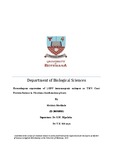| dc.contributor.author | Motlhale, Melitah | |
| dc.date.accessioned | 2016-07-15T06:49:11Z | |
| dc.date.available | 2016-07-15T06:49:11Z | |
| dc.date.issued | 2016-07-15 | |
| dc.identifier.uri | http://hdl.handle.net/10311/1467 | |
| dc.description | A dissertation submitted to the Dept. of Biological Sciences, Faculty of Science, University of Botswana in partial fulfilment of the requirement of the degree of Master of Science in Biological Sciences, Citation: Motlhale, M. (2015) Heterologous expression of LSDV immunogenic epitopes as TMV Coat Protein fusions in Nicotiana benthamiana plants, University of Botswana. | en_US |
| dc.description.abstract | Lumpy skin disease (LSD) is an economically important disease in Botswana. Currently the disease has no cure. In Botswana this disease is endemic; it has serious economic effects on beef export and the tourism industry. The only way of controlling LSD is by vaccination, separation of healthy animals from the diseased and killing or eliminating the diseased animals. Current strategies in vaccine production use intact or inactivated pathogen strains to induce immunity, as well as subunit vaccines which are commercially produced in yeast or mammalian cell cultures. Vaccine production is expensive. This study aimed at production of a candidate vaccine for lumpy skin disease using tobacco mosaic virus (TMV) as a vector for coat protein fusion production. The major immunodominant region in the lumpy skin disease virus (LSDV) is the P32 protein; two epitopes (LSDV-A and LSDV-B) from this protein were selected and used as antigens for the vaccine production. The epitopes were fused to the CP of TMV then cloned into a TMV based Agrobacterium compatible binary vector (pJL TRBO). Six weeks old Nicotiana benthamiana plants were agroinfiltrated with the recombinant TMV (rTMV). The rTMV was extracted from the plants three weeks post infection using polyethylene glycol (PEG) precipitation method. Reverse transcription polymerase chain reaction (rtPCR) of raw material from infected leaves showed that the rTMV was not expressed in the plants. The virus extracts showed that the LSDV epitopes were not successfully expressed in the plants; the epitopes were not attached to TMVCP. Western blots and ELISA showed that the rTMV was not able to elicit an immune response by reacting to anti-LSDV bovine sera. The study indicated the potential to develop a system to locally generate cheap and effective vaccines against LSDV even though there are some limitations that are to be eliminated. | en_US |
| dc.language.iso | en | en_US |
| dc.subject | Lumpy skin disease | en_US |
| dc.subject | endemic | en_US |
| dc.subject | economic effects | en_US |
| dc.subject | beef export | en_US |
| dc.subject | tourism industry | en_US |
| dc.subject | vaccination | en_US |
| dc.title | Heterologous expression of LSDV immunogenic epitopes as TMV Coat Protein fusions in Nicotiana benthamiana plants | en_US |
| dc.type | Masters Thesis/Dissertation | en_US |
| dc.link | Unpublished | en_US |

